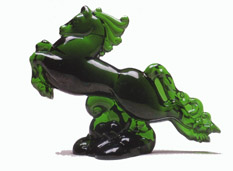For many centuries , the only source of light for households was the candle. Candles were originally held in simple candleholders. For every day people their candle holders or candlesticks were made from wood, wrought iron or brass. Pewter, silver or gold was used for the candlesticks in mansions or castles of the royal families or in churches.
The early candlesticks were simple shaped with a pricket in the base. This object called the pricket was a thin metal skewer, with a sharp point, on which the center of the candle base was pressed into to hold it in place.
Some time during the 14th century, a special socket was developed to the candle in place. The socket was a small cup-like device that enabled the candle to slide inside the top of the candlestick. The pricket was eliminated from most candlesticks. The old churches of Europe still use the pricket on large wooden columns for holding their large candles during services. This new design allowed for major changes in the style of the candlestick.
With the exploration of the New World, an abundance of silver was discovered enabling the vast majority of households to now have silver candlesticks that previously was so expensive.
The colonization of America and the establishment of glass factories here led to the development of mechanically pressed glass. Now, inexpensive glass could be mass produced making it available to the ordinary person. America took the world by storm with its ingenious designs of glass.
The Industrial Revolution made drastic changes in the lives of United States citizens. During this time time, plans were being made to bring a glass factory to the small town of Boston, Massachusetts. In 1825, the Sandwich Glass Manufactory was built by the Deming Jarvis family. Unfortunately, one year later the family found themselves strapped for cash. Orders were pouring in but they couldn’t be filled because of lack of manufacturing space at the factory. They needed to expand but didn’t have the capital. A solution was arrived at with the local financial institution. The company was reorganized in 1826 with Boston bankers being added to the Board of Directors. The company was then renamed Boston and Sandwich Glass Company.
Boston and Sandwich was the first major glass company to produce pressed items. This early pressed glass was meant to copy the more expensive cut glass. There was a shifting of plain designs to more ornate designs at this time.
Starting in 1828, candlesticks were first made but only on an occasional basis. With the start of the 1830s, glass candlesticks became very desirable and were made by a great many companies.
At this time, wood was the main resource used to heat the molten glass but the glass was unable to maintain a hot temperature for a long period of time and tended to cool too fast. This did not lend itself to the making of large pieces of glass since the glass cooled very rapidly. Sandwich developed a special technique called a pressed wafer process that was especially used for making candlesticks. The process involved taking two smaller pieces of glass and putting them together to form the candlestick.
The candlestick base was first made. In another mould, the socket was then made. A small bit of molten glass was then put on the top of candlestick, that formed a wafer, and then quickly, the socket was applied to this molten glass. The two parts then made the candlestick, which upon cooling would be forever bonded together. Occasionally, the two parts would be made in different colors offering a contrasting appearance to the final item. Because of the many Catholic workers at Boston and Sandwich, the company made several religious items including Crucifix candlesticks.
With the advent of kerosene lighting, the public soon lost interest in lighting their homes with candles. After 1870, very few candlesticks were made by the glass companies. The public no longer wanted them and so the companies ceased making them.
Though as with everything else, the public soon changed their minds again. By the late 1890s, the public now wanted candlesticks again. This time they wanted them to hold the candles they used as accent lights. It gave their homes a romantic and warm glow in the evening.
Glass candlesticks were once again in every home. All shapes and colors were made. With the start of the 1900s, art glass from Louis Comfort Tiffany and Frederick Carder provided exquisite candlesticks for the very wealthy. Through our century of change, many other types of candlesticks were made. Beginning with stretch and carnival glass treatments, a variety of candlesticks were offered. The Depression saw cheaper simple candlesticks offered in the 5 and dime stores of Woolworths and Kresge. They were also offered in different promotions and used as giveaways. The fine department stores offered very elegant made candlesticks from prestigious companies of Cambridge, Fenton, Fostoria, Heisey, Imperial and others. These glass candlesticks were blown, pressed or a combination of both enabling the company to make a very unique candlestick. Many also had very fancy etchings.
All the glass companies today continue to make glass candlesticks. Today they are used as accents to set a very elegant table unlike our ancestors that needed the candles to provide their only source of light. But even today in times of emergencies, most of us still revert to using the candle as a source of light when we lose our electricity during a winter storm. |

